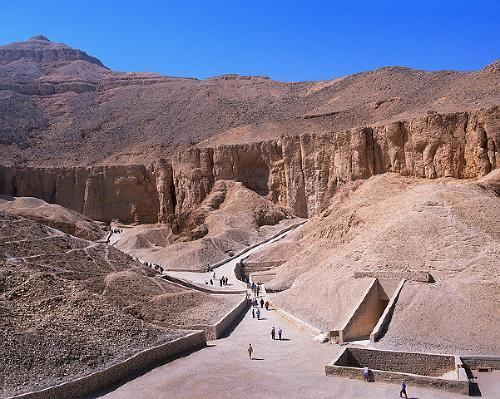Monuments Sight Seeing Attractions Meidum Necropolis
Monuments Sight Seeing Attractions Meidum Necropolis Snefru’s pyramid at Meidum was surrounded by many private burials of Dynasty IV – the first newly established elite cemetery since the archaic necropolis at Saqqara.
The fact that this necropolis was established gives credence to the suggestion that the Meidum pyramid did not collapse during its construction.
The mastaba cemeteries
are located to the north and east of the pyramid and provided some of the most well known of the Old Kingdom statuary and paintings.
On the eastern side of Snefru’s monument at the northern edge of the escarpment, there are several mastabas dating to the king’s reign.
The largest of these, located just outside the enclosure walls on the north-east corner of the pyramid is known as Mastaba 17, numbered by Petrie who investigated it in 1910.
The owner of this tomb is anonymous, but thought to be a royal prince, probably a son of Snefru. Inside the tomb Petrie found an uninscribed sarcophagus which is still in situ.
The earliest mummy Petrie found at Meidum was in 1891 and dated to Dynasty V, but this was destroyed when the London Royal College of Surgeons was bombed during the second world war.

Tomb of Nefermaat (Mastaba 16)
Nefermaat, who was also probably a son of Snefru, is the owner of a large mastaba tomb to the north of Snefru’s pyramid.
The tomb was investigated by Auguste Mariette in 1871, who found that the superstructure was built with mudbricks, while the inner walls were lined with limestone blocks decorated with painted scenes of daily life.
Monuments Sight Seeing Attractions Meidum Necropolis
There were two chapels located in the eastern part of the tomb, one at the south for Nefermaat and the northern one for his wife Itet.
It was in Itet’s tomb-chapel that Mariette found the famous scene of the ‘Meidum Geese’, one of the most skilfully painted pieces of Old Kingdom art (now on display in the Cairo Museum).
The tomb-owner’s status is obvious by the craftsmanship of the artists employed.
When Petrie excavated the tomb in 1892
he found more fragments of reliefs, especially of animals and hunting scenes.
Some of the scenes were painted while others were incised and filled with coloured vitreous paste – a technique which did not become widely used because it was too fragile.
Fragmentary scenes included trapping birds in the marshes with a clapnet, and agricultural activities which were to become the focus of later Old Kingdom tomb paintings.
One beautiful fragment showing the artists skill in depicting the detailed colored plumage of a bird can be seen in the British Museum. On the west wall of each chapel was an elaborate false door of the deceased.
Tomb of Rahotep (Mastaba 6)
The mastaba of Rahotep and his wife Nofret, son and daughter-in-law of Snefru, was also excavated by Mariette in 1871 and is situated to the north-east of Nefermaat’s tomb.
It is smaller than the former tomb, but its outer walls are impressively decorated with the ‘palace façade’ motif. The internal arrangements are similar to those of Nefermaat, Rahotep and his wife each having a tomb chapel on the western side.
Rahotep was a ‘King’s Son’ and ‘Priest of Heliopolis’, titles given in a scene on his false door where the deceased sits at an offering table before beautiful precisely carved hieroglyphs detailing the offerings he should receive (on a panel now in the Louvre Museum).
Other scenes from his chapel depict everyday life with pursuits such as hunting in the desert, fishing and trapping birds and agricultural scenes.
The most exciting find by Mariette’s workmen was two well known painted limestone statues of Rahotep and his wife Nofret, now on display in the Cairo Museum.
These extraordinary statues were in an excellent state of preservation – probably due to the fact that the chapels in the mastaba had for some reason been sealed off in ancient times, which resulted in a kind of serdab chamber.
The greatest effect of this was to preserve the colours on the statues so that they almost look freshly painted today.
The figures are each just over 120cm high and are seated on high-backed chairs with foot rests.
Rahotep is depicted with his own short black hair, he sports a splendid trimmed black moustache and around his neck he wears a single strand necklace with a heart amulet.
He wears a short white kilt and has one arm held horizontally across his bare chest.
The black painted hieroglyphs on the back of his chair give his name and titles.
Monuments Sight Seeing Attractions Meidum Necropolis
Nofret wears a shoulder-length dark wig with a circlet decorated with a flower motif around her head.
An elegant long white gown enfolds her and shows the straps of another garment beneath, also revealing an elaborate collar.
Her arms are folded across her chest and her skin is painted in a much lighter colour than her husband’s as was the tradition.
Her titles in hieroglyphs on the back of her chair name her as ‘King’s Acquaintance’.
The most outstanding feature of the statues is that they both retain their lifelike inlaid eyes of crystal which terrified the Egyptian workmen who first saw them staring out of the tomb.
It would appear that many of the tombs built at Meidum were unfinished and never used for burials, probably due to the fact that Snefru moved his pyramid city to Dashur while constructing his pyramids there.
How to get there
Coming from the north, the Cairo-Asyut desert highway will take you to Meidum Pyramid. From the south, it can be reached from the Beni Suef to Faiyum road.
The tombs currently open are Mastaba 17 on the north-east side of the pyramid, Rahotep and Nofret and Nefermaat, about 1km to the north.
Contact us
[youtube_channel]
[gmap-embed id=”867″]


